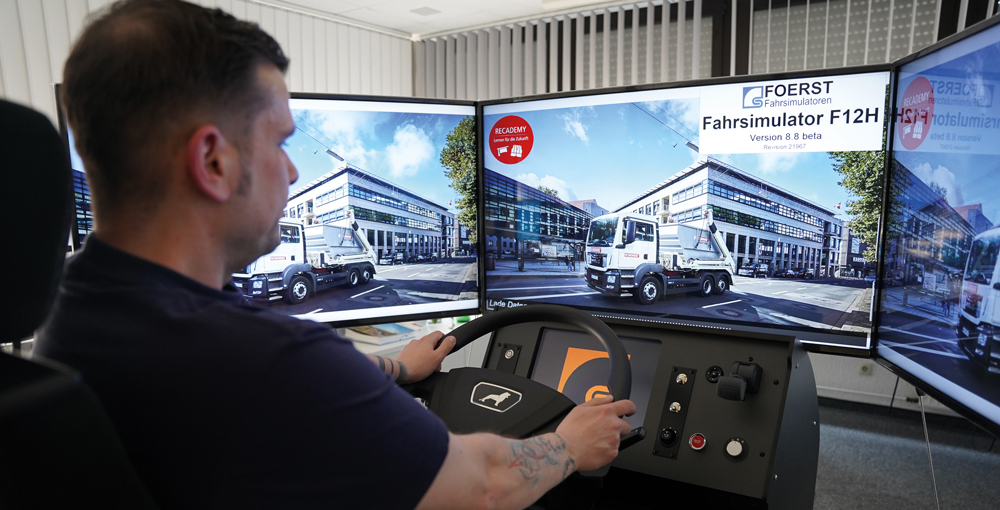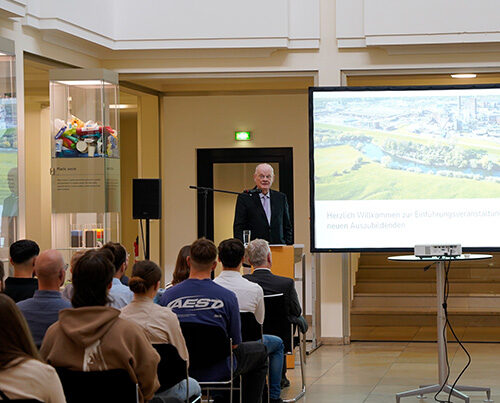For many years now, technological solutions have been developed and implemented to make it easier for drivers to see what’s happening around their lorries. Using blind spot assist systems can help to defuse many dangerous situations. It is a big risk, though, to rely completely on technical aids. It is essential that all road users are both attentive and considerate to minimise the risk of an accident. Making HGV drivers aware of these risks is a big part of their basic and further training courses. The problem here, though, is that it is not possible to practise being in many dangerous situations – either on the training ground or on the roads. How online courses and an HGV simulator can close this safety gap? Accelerating towards greater driver safety!
As always, Lisa is travelling to work by bike. It’s not a particularly long way but it gives her enough time to work out in her head what tasks she needs to do today. A relaxed start to her working day, therefore, were it not for that one dicey spot: a major crossroads with several turn-off lanes. The traffic light turns green and Lisa starts pedalling. But then she hears a lorry approaching from behind. Within no time at all it is level with her. Lisa decides to brake – and is very lucky indeed. A few seconds later, the lorry starts turning right and only just manages to stop in time. That could have ended very differently!
One of the first questions that learner drivers are asked in Germany is: “Why must you stop before turning right?” The answer is simple: because there may be a pedestrian or cyclist in their blind spot. This is a small but so important area at the side of a vehicle that is difficult for a driver to see des-pite their mirrors and cameras. According to the BMDV [Federal Ministry for Digital and Transport], there were around 9,906 right turn accidents in 2019 that left people injured. The main reason for these: the blind spot. Blind spots are a permanent risk – especially for HGV drivers who, sitting high up in their cabs, are unable to see everything happening around them.
Technical solutions need to be brought in to reduce the risk of right turn accidents. Regulation (EU) 2019/2144, for example, stipulates that all new EU type approvals for buses and lorries must be equipped with a blind spot assist system from 06 July 2022 onwards; the same will apply to all newly registered vehicles in the EU after 07 July 2024. As far as the technology is concerned, this means that a driver will hear an aud-ible warning if a person is next to their vehicle in their blind spot. The driver can brake and prevent a collision. The UDV [German Insurers Accident Research] has calculated that the use of blind spot assist systems could reduce right turn accidents by 60%. That is certainly a good start.

Regulation (EU) 2019/2144 stipulates that all new EU type approvals for buses and lorries must be equipped with a blind spot assist system from 06 July 2022 onwards; the same will apply to all newly registered vehicles in the EU after 07 July 2024.
Routine is a driver’s enemy
No matter how much the technical devices have been improved over the years, however, it is still people sitting behind the wheel. People who drive their lorries from A to B every single day. And, in the best case scenario, do this safely. It is not enough for them to rely on their technical aids and on them working properly. There is something else: the right-hand-turn blind spot is just one of many risks. Other common causes of lorry accidents include driving too fast, not leaving enough space to the vehicle in front and, the number one reason, the driver being distracted. Every HGV driver learns about the necessary tools of their trade when they do their apprenticeship: How do you drive a lorry and what are the everyday tasks? Over the years, though, driving their vehicle becomes routine: I’ll just grab my mobile to swap songs. I’ll just take a bite of my sandwich to stop my stomach grumbling. “I’ll just” can quickly be their undoing. These seemingly routine actions can distract them from what is important – namely keeping their eyes on the road and on the other road users.

60% of right turn accidents could be avoided by using blind spot assist systems
“Routine is the enemy of many drivers and can lead to a high rate of accidents,” commented Paul Fikus, who is responsible for training and further training HGV drivers and automotive mechatronics specialists in REMONDIS’ west region. “No one voluntarily wants to have an accident,” he points out. It is more a question of carelessness creeping in over the years: an ‘I know exactly how my vehicle works’ attitude. That’s true certainly. But once a person has learned to drive a lorry, they must also be regularly reminded about what a responsibility it is to handle such a large vehicle. Driver safety awareness, therefore, is an essential component for all driver training and further training courses. In any case, the requirements for professional HGV drivers are much stricter than those for private individuals. HGV drivers are not solely responsible for road safety. If they want to keep their HGV driving licence, however, they must take part in modular training courses every five years – something that makes sense simply because of the size of the vehicles, the goods they transport and the area they are operating in.

Paul Fikus and his trainer colleagues based in the town of Herne have been looking at ways to optimise their training programme for a long while now. It is especially important to make drivers aware of risks, to pass on individual experiences and increase specific skills as it is often simply not possible to physically practise many situations in advance. “We want to help our drivers and have a sustainable training programme to support them long term. This is all about showing that we appreciate our staff,” said Alexander Bartz, who is also a driving instructor and trainer at the Herne business. Paul Fikus added: “We are a family-run company and want to reflect this in our everyday work. This means growing our drivers’ skills and developing a wide range of in-house further training opportunities.”
In the future, it should be made easier for HGV drivers to take part in further training courses that reflect their needs and are available when they need them. They should also be able to suggest topics that are relevant to their jobs so that these can be incorporated into future courses. “This helps us to remain close to the action and teach specific subjects that will help our drivers,” explained Alexander Bartz. “It’s all about talking to one another and exchanging experiences.”
HGV drivers must take part in modular training courses every five years if they want to keep their HGV driving licence.
RECADEMY Drive goes live
A first step has already been taken in this direction: drivers can now learn more about specific subjects by taking part in online courses, so-called e-learning.
This e-learning offering is gradually being set up and uploaded onto the company’s RECADEMY platform. The individual courses are interactive, examine real driving situations and use questions and images to get the participants actively involved. This is, therefore, a very vivid way to teach, refresh and consolidate knowledge. Online courses proved to be a particularly useful addition to in-person courses during the Covid-19 pandemic.
The first online driver safety awareness course went live in February 2022. This takes a detailed look at the dangers of driving too close to the vehicle in front, of driving too fast and of being distracted behind the wheel. Paul Fikus and Alexander Bartz use real stories in these courses and deliberately make them emotional: “No family should be torn apart because of a driver glancing at their mobile.” What is clear at the end of the course is that drivers who drive attentively and considerately also drive more safely.
This, though, is just the beginning: further e-learning courses are already being planned. The second course will present the fundamentals of the digital tachograph. An important subject – at the end of the day, adhering to the driving times and breaks avoids fines and prevents accidents being caused by overspeeding or tiredness.
It is also possible that courses will be developed in the future to teach the drivers, step by step, about how their lorries are designed, especially when new generations of vehicles are launched onto the market: How are they different to the previous gener-
ations? How has the cockpit been designed? What is the best way to secure the goods I’m transporting? Eco-driving, first responder skills, fire protection – there really is no end to the list of possible course subjects. And these online courses can also be used to gradually train new employees and make them aware of possible risks.
Finding new drivers is certainly a big subject in the industry. “Generally, you can say that there is a serious shortage of HGV drivers in Germany across all fields of logistics,” said Paul Fikus describing the current situation. “What’s more, demographic change will lead to a large number of drivers leaving us over the next few years. This means vacancies that will have to be filled and new drivers that will need additional training.” This is where the online courses will come into play as they can be accessed anywhere and at any time, are concise and pass on facts in an entertaining way.
Drivers can now learn more about specific subjects by taking part in online courses, so-called e-learning.

Bespoke learning opportunities
RECADEMY Drive is the central contact point, the headquarters so to speak, for all apprenticeship and further training courses in the west region involving HGV drivers and automotive mechatronics specialists. The west region has around 14 apprenticeship/training centres and between 800 and 900 HGV drivers. Everything that is developed here will eventually be passed on to all of the REMONDIS Group’s other business locations.
Besides giving regular modular training courses, most of which are taught in person, the driving instructors are always searching for new ways to impart knowledge. Which is why they came up with the idea of developing online courses for HGV drivers – a means to pass on driver-specific knowledge that can be adapted to meet individual needs.
A highlight in the fleet
The driving instructors, however, do not want to just offer online courses to make it easier to train and further train new employees, apprentices and long-standing members of staff. An HGV simulator was also recently installed at the business in Herne. The fleet’s newest device provides a realistic experience and can teach drivers about safe and fuel-efficient driving and how to react to potentially dangerous situations.
For anyone sitting in the driver’s seat, the three screens create a fully immersive experience simulating the streets and traffic in the real world. Practice and training trips can be carried out, repeated whenever necessary and compared to one another. This enables a person’s driving style to be analysed; targeted measures can be taken to iron out any weaknesses. The simulator can also be programmed so that drivers can practise manoeuvring all types of trailers and semi-trailers. “Every extra subject that we are able to teach the apprentice drivers when they are learning is one less subject to teach later on. That saves time and increases safety,” Paul Fikus explained.
The driving simulator is currently located in Herne where it is being put through its paces and prepared for its future use. In the future, it will be installed onto a lorry so that it can be deployed at other branches as well.

The HGV simulator provides a realistic experience and can teach drivers about safe and fuel-efficient driving and how to react to potentially dangerous situations.
Staying alert behind the wheel
Peter has been an HGV driver for over 20 years and knows his lorry like the back of his hand. Today is a particularly hectic day. His route takes him past a dicey spot: a major crossroads with several turn-off lanes. When the traffic lights turn green, Peter puts his foot on the accelerator and turns on his indicator. Suddenly he hears a warning sound and slams on the brakes. A cyclist appears next to his lorry – a cyclist he had almost collided with. That was a close shave!
Last week, Peter took part in an online training course that reminded him how important it is to stay alert behind the wheel and keep a close eye on the other road users. How right they were! Thank goodness the blind spot assist system was working. But what about the next time? What if the device stops working properly? Peter is relieved that his employer is so focused on the subject of driver safety awareness and has introduced e-learning courses and an HGV simulator so he can practise dealing with tricky situations as often as he needs to. In the future, he will be able to refresh his knowledge far more often and remind himself of the dangers lurking on every street corner.
Keeping out of the blind spot
Making people more aware of the dangers on the road has nothing to do with age as can be seen here: REMONDIS regularly teams up with local police forces and DEKRA to visit primary schools so that the pupils can see close up just how big lorries are and why the blind spots are so dangerous. One after another, the children can climb into the cab of a skip lorry – and they are always astonished when the whole of their class disappears in the lorry’s blind spot.
Many primary schoolchildren go to school on foot or by bike. This project should help make them more aware of road safety so that there are fewer accidents involving the most vulnerable road users, such as cyclists and pedestrians.
Image credits: image 1: Adobe Stock: ipopba; image 2: Adobe Stock: SciePro, Markus Mainka; image 3: REMONDIS; image 4: Adobe Stock: ipopba












